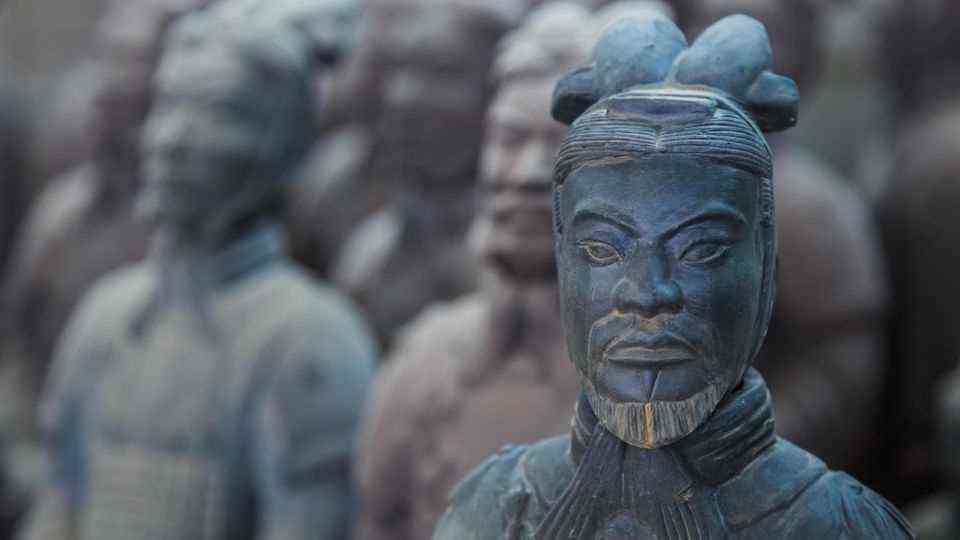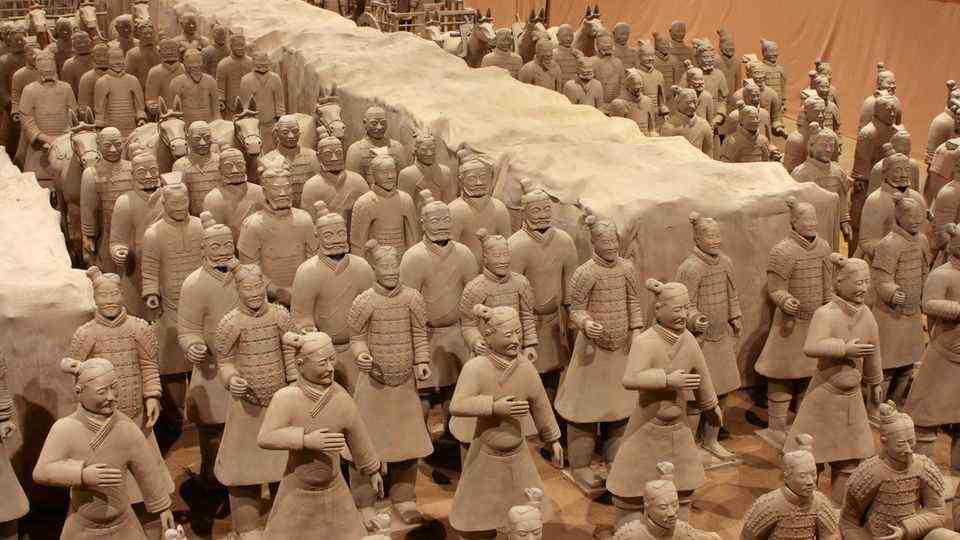Imperial tomb
Cosmic rays are said to trace the grave of the mysterious first emperor under his terracotta army
About 8,000 men protected the emperor.
© Wei Bo // Picture Alliance
The terracotta soldiers guard their emperor’s grave to this day. Chinese scientists have now developed a miniature muon detector. They want to use it to track down the burial chamber in the depths of the necropolis.
Beijing faces a problem: How can you explore the inner secrets of the tombs of the first emperor Qin Shi Huang without destroying the terracotta army guarding him?
In the early days of archeology, seekers were quite unscrupulous. When they were looking for a treasure or a royal tomb, the layers above were ruthlessly removed. This is not how the Chinese want to proceed today. The finds are only exposed if it is guaranteed that they can also be preserved and preserved. Today it is estimated that the emperor was surrounded by around 8,000 men. 2000 have already been brought to light.
The surroundings preserved the blaze of color
“When the ceramic figures were first excavated, they were mostly colored, with red belts and dark armor, but we lacked conservation skills and the colors were fading,” said archaeologist Liu Zheng.
But despite the enormous effort – there are videos circulating showing hundreds of conservators at work – it is impossible to predict when the huge facility will be exposed. Hundreds of thousands worked on the city of the dead for over 40 years; it is 70 times the size of the emperor’s seat in Beijing – the so-called “Forbidden City”.
Occult Myth
There the first emperor is guarded by thousands of soldiers from his terracotta army, they represent the first Qin army. The work must be done very carefully, because the bright colors of the soldiers quickly fade under the influence of oxygen. China is proud of the Terracotta Army, but the greatest secret lies beneath it. The necropolis was never opened and looted. Everything is in the same condition as it was at the time of the death of the first emperor. So the burial chamber must still be intact and there is Huang’s coffin, which was built from 221 BC onwards. BC ruled for eleven years. The treasures of the city of the dead are only a reflection of the finds waiting in this chamber. There are also countless legends about the last resting place of the cruel emperor. China’s first emperor was possessed by occult powers, he is said to have searched for eternal life with magic.
So it’s no wonder that the scientists didn’t want to wait hundreds of years for the salvage work to reach the chamber. You want to use what is known as a muon detector to track down space. These particles are created when cosmic rays hit the earth’s atmosphere. The muons are absorbed by thick, dense objects, but penetrate lighter materials. Such detectors have already been used in pyramids, volcanoes and caves.
Need for a detector
“As an ancient civilization with a long history, China has a large number of cultural relics that need archaeological research,” said Beijing Normal University scientists. “For the non-intrusive detection of the internal structure of some large artifacts, such as imperial tombs, the traditional geophysical methods used in archeology have certain limitations. The application of muon absorption in the archaeological field can be an important addition traditional geophysical methods, “they hope.
The researchers are convinced that the method will be successful. Before starting the actual work, they created and buried dummies of burial chambers in order to check the performance of the detector. With success, now you are convinced that your device will find the real chamber. The detector was specially developed for this task. Dikun Yang, assistant professor of geophysics at the Southern University of Science and Technology in Shenzhen, said he had gotten so small that he could be carried by a child. The size is important because the detector cannot simply be dragged across the surface in a cart, it is lowered into the ground. The smaller the device, the easier it is to bring it down without damaging other objects found.
Founder of the empire
Qin Shi Huang worried about his life from a young age. The construction of his tomb began when he ascended the throne of Qin – one of the then Chinese states. He was only 13 years old at the time. Qin Shi Huang conquered the other states and is therefore considered to be the first unifier of the empire. His reforms in administration, language, and measures and weights shaped the Chinese Empire. He is also considered the founder of the Great Wall of China, which had its origins in its fortifications.
Qin Shi Huang was a rational power man, but also had an enormous interest in the occult. Especially in eternal life. On “imperial inspection trips” he tried to find magicians or alchemists who would brew him an elixir of life. The unique mausoleum must also be seen in this context.





